ASP.NETでTraceListener使ってますか?今まで結構仕込んでおいたんだけど、ファイルやイベントログだと扱いにくいなー、なんて思ってませんか。思ってました。融通効かないなー、と。大規模サイトなんかでSQLServerに入れちゃうと、大変なことにナチャウヨ。
そこでMongoDB。みんな大好きMongoDB。ドキュメントの日本語化も着実に進んでるので、英語なんてー、と気にすることもあんまりないでしょう。そーでもないですか?いろいろ可愛いやつですよ!ログデータの保持なんて、もう、得意中の得意です。保持する構造さえちゃんとしておけば、RDBじゃ処理しにくいものもお気楽に扱えます。用途と使い方次第デスけどね。
Home - Docs-Japanese - 10gen Confluence
MongoDBって何よ?っていうのは、いろいろ検索してね。
MongoDB と NoSQL を試す
MongoDB と NoSQL を試す (第 2 部)
MongoDB と NoSQL を試す (第 3 部)
開発環境で超簡単な使い方はコンソールでmongodを起動しておいて、mongoで中身を確認。
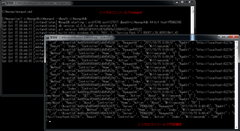
だんだんmongodをサービス起動しておきたくなりますが、最初は単なるプロセス起動。もちろん、内容確認をコンソールのmongoで行うのも、ハッカーみたいな雰囲気あっていいかもしれないけど、そんなの面倒なので実際はGUIのツールを使いましょう。
MongoVUE | Gui tools for MongoDB
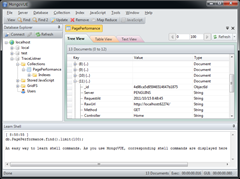
他にもイロイロあるので、気に入ったのを選んで試してみましょう。
Admin UIs – MongoDB
このMongoDBにTraceListenerからmessageを保存するようにしちゃいましょー!
開発するならHTTPでのREST操作(MongoDBに最初からあります)よりも、Driverを使った開発のほうが楽チンぽんです。前までは、いろいろ使い勝手の問題もあったりとかしたけど、いまとなっては標準公開されてるもので十分です。
CSharp Language Center – MongoDB
CSharp Driver Tutorial - MongoDB
英語かよ!どんまい。
マニュアル - Docs-Japanese - 10gen Confluence
なんにせよNuGetで取得できるのが便利なところです。
Official MongoDB C# driver - 1.2 : NuGet gallery
TraceListenerって自分で用意したことなかったんだけど、TraceListenerクラス派生でいいってことなので、お手軽ですね。必須なoverrideも2個だけ。
public override void Write(string message)
{
// ...
}
public override void WriteLine(string message)
{
// ...
}
やれそうですね。えいやっ!
using System.Configuration;
using System.Diagnostics;
using MongoDB.Bson;
using MongoDB.Driver;
namespace MongoListener
{
public class MongoDbTraceListener : TraceListener
{
private readonly MongoServer _server;
private readonly MongoDatabase _database;
private readonly string _collectionName;
public MongoDbTraceListener() : this("TraceData") { }
public MongoDbTraceListener(string initializeData)
{
_collectionName = initializeData;
var serverName = ConfigurationManager.AppSettings["MongoDb:Server"];
var databaseName = ConfigurationManager.AppSettings["MongoDb:Database"];
if (string.IsNullOrEmpty(serverName))
serverName = "mongodb://localhost";
if (string.IsNullOrEmpty(databaseName))
databaseName = "TraceListener";
_server = MongoServer.Create(serverName);
_database = _server.GetDatabase(databaseName);
}
private void Insert(BsonDocument document)
{
var collection = _database.GetCollection(_collectionName);
collection.Insert(document);
}
private void InternalWrite(string message)
{
var document = new BsonDocument {{"Message", message}};
Insert(document);
}
private void InternalWriteObject(object o)
{
var document = new BsonDocument();
var type = o.GetType();
foreach(var prop in type.GetProperties())
{
document.Add(prop.Name, prop.GetValue(o,new object[]{}).ToString());
}
Insert(document);
}
public override void Write(string message)
{
InternalWrite(message);
}
public override void WriteLine(string message)
{
InternalWrite(message);
}
public override void WriteLine(object o)
{
var type = o.GetType();
if (type.Name.StartsWith("<>") && type.Name.Contains("AnonymousType"))
{
InternalWriteObject(o);
return;
}
InternalWrite(o.ToString());
}
}
}
できたー。後は、web.configに書いて使えるようにするだけですね!
<appSettings>
<add key="webpages:Version" value="1.0.0.0"/>
<add key="ClientValidationEnabled" value="true"/>
<add key="UnobtrusiveJavaScriptEnabled" value="true"/>
<add key="MongoDb:Server" value="mongodb://localhost"/>
<add key="MongoDb:Database" value="TraceListener"/>
</appSettings>
<system.diagnostics>
<trace autoflush="false" indentsize="4">
<listeners>
<add name="mongoListener"
type="MongoListner.MongoDbTraceListener, MongoListner"
initializeData="MyTrace" />
<remove name="Default" />
</listeners>
</trace>
</system.diagnostics>
<system.web>
<trace enabled="true"/>
あとはSystem.Diagnostics.Trace.Write/WriteLineです!すでにたくさん仕込んでいる場合にはコレでOK。ASP.NET MVC3標準プロジェクトを作成して、MongoDbTraceListenerクラスを作成し、HomeControllerのIndexアクションにTraceを書いてみましょう。
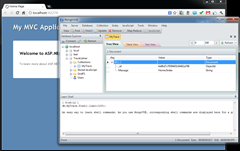
わーお!素敵!!
MongoDBが違うマシンだったり(本番はそうしましょう)、Database名を変更したいときはappSettingsの値を変えてね。コレクション(テーブル相当)の名前を変えたかったらtrace/listnersのinitializeDataで指定してね。
ちなみに、これだけだとつまんないので、ここから少し拡張してパフォーマンス計測してみましょう。まずはIHttpModuleを実装して、リクエストの処理時間を計測するようにしてみます。
mvc-mini-profiler - A simple but effective mini-profiler for ASP.NET and WCF - Google Project Hosting
↑パフォーマンス計測ならこんな素敵なもの(NuGit.orgで実物見れますよ~)もありますが...。これから新規ならこっちのほうが...。いや、言うまい。
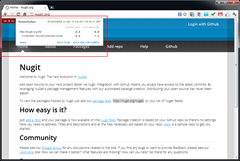
どりゃ!
using System;
using System.Collections.Generic;
using System.Diagnostics;
using System.Linq;
using System.Web;
namespace MongoListner
{
public class PerformanceTraceModule : IHttpModule
{
private string ItemKey = "_mongoDbTraceStart";
private readonly string _serverName = "";
public PerformanceTraceModule()
{
_serverName = Environment.MachineName;
}
public void Init(HttpApplication context)
{
context.BeginRequest += new EventHandler(context_BeginRequest);
context.EndRequest += new EventHandler(context_EndRequest);
}
void context_BeginRequest(object sender, EventArgs e)
{
var httpContext = (sender as HttpApplication).Context;
var startTime = httpContext.Items[ItemKey] = DateTime.Now;
}
void context_EndRequest(object sender, EventArgs e)
{
var httpContext = (sender as HttpApplication).Context;
var startTime = (DateTime)httpContext.Items[ItemKey];
Trace.WriteLine(new
{
Server = _serverName,
RequestAt = startTime,
Method = httpContext.Request.HttpMethod,
Status = httpContext.Response.StatusCode,
RawUrl = httpContext.Request.Url.ToString(),
Milliseconds = (DateTime.Now - startTime).Milliseconds
});
}
public void Dispose()
{
}
}
}
これを利用するためにsystem.webServer/modulesに登録します。 <system.webServer>
<validation validateIntegratedModeConfiguration="false"/>
<modules runAllManagedModulesForAllRequests="true">
<add name="mongoListener"
type="MongoListner.PerformanceTraceModule, MongoListner"
preCondition="integratedMode"/>
</modules>
</system.webServer>
実行してみます。
BeginRequestからEndRequestの間を計測するものですが490msって...。遅すぎ!

と、思ったらF5リロードの2回目は5ms。そーだろそーだろ。ん?よく見たらStatusとMillisecondsがstringになってるー。TraceListenerのInternalWriteObjectでToStringしてたね。失敬。そこは修正しましょう。書きながら作る、作りながら書く!
private void InternalWriteObject(object o)
{
var document = new BsonDocument();
var type = o.GetType();
foreach(var prop in type.GetProperties())
{
var value = BsonValue.Create(prop.GetValue(o,new object[]{}));
document.Add(prop.Name, value);
}
Insert(document);
}
これでちゃんと型どおり。BsonValueにはいろいろあるのでドキュメント参照してみてください。このHttpModuleがあればすべてのリクエストの処理時間が計測できますね!アクセスログのTimeTakenとダダカブリ。どんまい。
IIS 6.0 ログ ファイルの Time Taken フィールドは何を表し、何を意味していますか。 : IIS 6.0 についてよく寄せられる質問
ASP.NET MVCならActionFilter属性を使ってControllerでの処理時間とViewの処理時間をそれぞれ別で計測できてなお嬉しいはず。
そいやっ!
using System;
using System.Diagnostics;
using System.Web.Mvc;
namespace MongoListner
{
public class PerformanceTraceAttribute : ActionFilterAttribute
{
private string ItemKey = "_mongoDbFilterTraceStart";
private readonly string _serverName = "";
public PerformanceTraceAttribute()
{
_serverName = Environment.MachineName;
}
public override void OnActionExecuting(ActionExecutingContext filterContext)
{
filterContext.HttpContext.Items[ItemKey] = DateTime.Now;
base.OnActionExecuting(filterContext);
}
public override void OnActionExecuted(ActionExecutedContext filterContext)
{
var startTime = (DateTime)filterContext.HttpContext.Items[ItemKey];
Trace.WriteLine(new
{
Server = _serverName,
ProcessAt = DateTime.Now,
RawUrl = filterContext.HttpContext.Request.Url.ToString(),
Method = filterContext.HttpContext.Request.HttpMethod,
Controller = filterContext.RouteData.GetRequiredString("controller"),
Action = filterContext.RouteData.GetRequiredString("action"),
Milliseconds = (DateTime.Now - startTime).Milliseconds
});
base.OnActionExecuted(filterContext);
}
public override void OnResultExecuting(ResultExecutingContext filterContext)
{
filterContext.HttpContext.Items[ItemKey] = DateTime.Now;
base.OnResultExecuting(filterContext);
}
public override void OnResultExecuted(ResultExecutedContext filterContext)
{
var startTime = (DateTime)filterContext.HttpContext.Items[ItemKey];
var viewName = (string) null;
if (filterContext.Result is ViewResult)
{
viewName = (filterContext.Result as ViewResult).ViewName;
}
Trace.WriteLine(new
{
Server = _serverName,
ProcessAt = DateTime.Now,
RawUrl = filterContext.HttpContext.Request.Url.ToString(),
Result = viewName ?? filterContext.Result.GetType().Name,
Controller = filterContext.RouteData.GetRequiredString("controller"),
Action = filterContext.RouteData.GetRequiredString("action"),
Milliseconds = (DateTime.Now - startTime).Milliseconds
});
base.OnResultExecuted(filterContext);
}
}
}
これを有効にするためにGlobal Filterに追加しておきましょう。あとは実行するだけ!
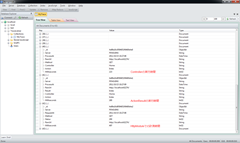
ズームして見てね。
Controllerでの実行時間が223ms、ActionResultの実行時間が180ms、HttpModuleでの計測時間が497ms。差が94msありますね。そんなもんでしょう。ちなみにコレが初回実行時の計測で、2回目は↓。

Controllerでの実行時間が0ms、ActionResultの実行時間が0ms、HttpModuleでの計測時間が10ms。差が10ms。これまた、そんなもんでしょう。
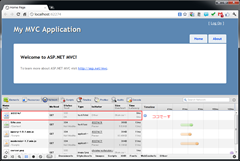
こんな感じです!楽しいですね!
途中、MongoDBに入れるDocumentのカラムを変更したりしてるけど、MongoDB側へは何も手を加える必要がないんです。ドキュメント単位(テーブルなら行単位)にカラム構成が変更されてもお構いなしです。ちなみにサーバーさえいればDatabaseもCollectionも初回アクセス時に勝手に作られるので準備は不要。この手軽さと、レスポンス性能の高さがMongoDBの魅力です。
今回のプロジェクト一式は↓こちら。ローカルにMongoDBさえ入っていればそのまま動くはず。
※ファイルを小さくするために、packages/mongocsharpdriver.1.2を消してます。

